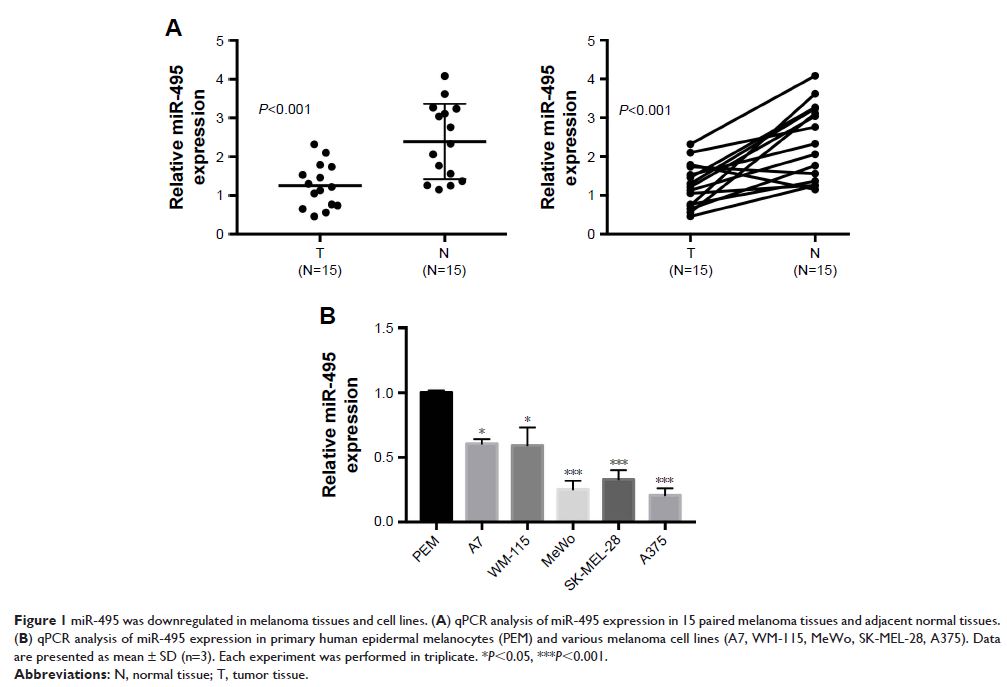108985
论文已发表
注册即可获取德孚的最新动态
IF 收录期刊
- 3.4 Breast Cancer (Dove Med Press)
- 3.2 Clin Epidemiol
- 2.6 Cancer Manag Res
- 2.9 Infect Drug Resist
- 3.7 Clin Interv Aging
- 5.1 Drug Des Dev Ther
- 3.1 Int J Chronic Obstr
- 6.6 Int J Nanomed
- 2.6 Int J Women's Health
- 2.9 Neuropsych Dis Treat
- 2.8 OncoTargets Ther
- 2.0 Patient Prefer Adher
- 2.2 Ther Clin Risk Manag
- 2.5 J Pain Res
- 3.0 Diabet Metab Synd Ob
- 3.2 Psychol Res Behav Ma
- 3.4 Nat Sci Sleep
- 1.8 Pharmgenomics Pers Med
- 2.0 Risk Manag Healthc Policy
- 4.1 J Inflamm Res
- 2.0 Int J Gen Med
- 3.4 J Hepatocell Carcinoma
- 3.0 J Asthma Allergy
- 2.2 Clin Cosmet Investig Dermatol
- 2.4 J Multidiscip Healthc

miR-495 通过抑制黑素瘤细胞中的 PBX3 抑制增殖、迁移和侵袭并诱导细胞凋亡
Authors Chen G, Xie Y
Received 22 September 2017
Accepted for publication 31 December 2017
Published 5 April 2018 Volume 2018:11 Pages 1909—1920
DOI https://doi.org/10.2147/OTT.S152362
Checked for plagiarism Yes
Review by Single-blind
Peer reviewers approved by Dr Narasimha Reddy Parine
Peer reviewer comments 2
Editor who approved publication: Dr Jianmin Xu
Background: Amounting evidence indicate that miRNAs play an important role in the
development of various cancers. MiR-495 is a potential tumor suppressor in
cancers, however its role in melanoma is still elusive. The study aimed to
investigate the role of miR-495 and the underlying mechanisms in melanoma
cells.
Methods: The levels of miR-495 in melanoma tissues and cell lines were
measured by quantitative real-time polymerase chain reaction. Mimics of miR-495
was transfected into human melanoma cells A375 and MeWo. Cell viability of
miR-495-transfected cells was assayed by MTT assay. Cell migration and invasion
of miR-495 transfected cells were measured by wound healing assay and transwell
assay, respectively. Nucleosome enzyme-linked immunosorbent assay was performed
to measure the apoptosis induced by overexpression of miR-495. Luciferase
reporter assays were performed to verify the interaction between miR-495 and
its target PBX3.
Results: It was found that the expression levels of miR-495 were
down-regulated in melanoma tissues and cells. Moreover, overexpression of
miR-495 inhibited melanoma cell proliferation, migration and invasion in vitro.
PBX3 was identified as a target for inhibition by miR-495 and was confirmed by
luciferase assay, quantitative real-time polymerase chain reaction and western
blot. We also indicated that silencing of PBX3 also repressed melanoma cell
proliferation, migration and invasion in vitro.
Conclusion: In summary, our findings demonstrated that miR-495 functions as a tumor
suppressor in human melanoma via directly targeting PBX3.
Keywords: melanoma, miR-495, PBX3, cell migration, cell invasion
